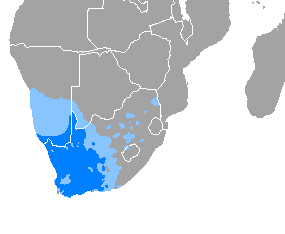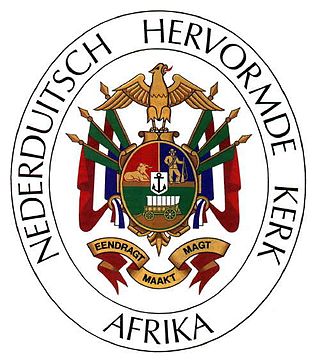
Afrikaans is a West Germanic language that evolved in the Dutch Cape Colony from the Dutch vernacular of Holland proper used by Dutch, French, and German settlers and people enslaved by them. Afrikaans gradually began to develop distinguishing characteristics during the course of the 18th century. Now spoken in South Africa, Namibia and Botswana, Zambia, and Zimbabwe, estimates c. 2010 of the total number of Afrikaans speakers range between 15 and 23 million. Most linguists consider Afrikaans to be a partly creole language.

The South African Republic, also known as the Transvaal Republic, was an independent Boer republic in Southern Africa which existed from 1852 to 1902, when it was annexed into the British Empire as a result of the Second Boer War.

The Dutch Reformed Church is a Reformed Christian denomination in South Africa. It also has a presence in neighbouring countries, such as Namibia, Eswatini, and parts of Botswana, Zimbabwe and Zambia. In 2013 it claimed 1.1 million members and 1,602 ordained ministers in 1,158 congregations.

The Reverend Stephanus Jacobus du Toit was a controversial South African nationalist, theologian, journalist and failed politician. In his younger years Du Toit did much to promote the Afrikaans language as a symbol of Afrikaner nationalism. Apart from the years 1882-8 when he was Superintendent of Education in the South African Republic, he lived in or near the town of Paarl in the Cape Colony. Disillusionment with the Kruger regime led him, in later years, to moderate his views. He was instrumental in initiating the translation of the Bible into Afrikaans and was a proponent of the Afrikaans language. He died an outcast.

Johan Adam Heyns (1928–1994) was an Afrikaner Calvinist theologian and moderator of the general synod of the Nederduits Gereformeerde Kerk (NGK) in South Africa. He was assassinated at his home in Waterkloof Ridge, Pretoria.

Warmbad is a settlement located in the ǁKaras Region of southern Namibia. It is situated south of Karasburg at the Homs River, close to the border with South Africa, and belongs to the Karasburg electoral constituency.

The Dutch Reformed Church in Africa is a Reformed Christian denomination based in South Africa. It also has congregations in Namibia, Botswana, Zambia and Zimbabwe. Along with the Dutch Reformed Church in South Africa (NGK) and the Reformed Churches in South Africa, the NHKA is one of the three Dutch Reformed sister churches of South Africa. The NHKA retains the old Nomenclature Nederduitsch, the word originally referring to the Dutch language. The word refers to the Low Saxon language today. The Dutch language remained the official language of the church until 1933 when the church started functioning almost exclusively in Afrikaans.

Afrikaners are a South African ethnic group descended from predominantly Dutch immigrants first arriving at the Cape of Good Hope in 1652. Until 1994 they dominated South Africa's politics as well as the country's commercial agricultural sector. Afrikaners make up approximately 5.2% of the total South African population, based upon the number of White South Africans who speak Afrikaans as a first language in the South African National Census of 2011. Afrikaans, South Africa's third most widely spoken home language, evolved as the mother tongue of Afrikaners and most Cape Coloureds. It originated from the Dutch vernacular of South Holland, incorporating words brought from the Dutch East Indies and Madagascar by slaves.
Wolvengat, also known as Viljoenshof, is a village in the southern Overberg region, in the Western Cape province of South Africa. It is situated 10 kilometres (6 mi) south of Elim and 35 kilometres (22 mi) southwest of Bredasdorp. It was originally named Wolfgat or Wolvengat in reference to the brown hyena, known as strandwolf in Afrikaans. However, when the local post office was established the authorities named it Viljoenshof in honour of DJ Viljoen, the Dutch Reformed (NGK) minister of Bredasdorp from 1904 to 1934; this name was then extended to the village. The original name Wolvengat was officially restored in 1991.
Boerehaat is an Afrikaans word that means "ethnic hatred of Boers" or Afrikaners as they became known after the Second Boer War. The related term Boerehater has been used to describe a person who hates, prejudices or criticises Boers or Afrikaners.

The Afrikaanse Protestantse Kerk, also known as AP Kerk, is a South African conservative Reformed Church federation with about 35,000 adherents. The federation consists of 210-240 congregations, mostly in South Africa, although the APK also includes 7 congregations in Namibia and one in London, England.
David Pieter Faure was the founder of the Unitarian Church in South Africa, an interpreter and a Grand Master of the Freemasons in South Africa.
The Alhambra Bioscope, also known as the Alhambra Theatre, was a theatre that opened on Riebeek Street, Cape Town, South Africa in 1929.
The Johannesburg Reformed Church was the first congregation of the Dutch Reformed Church in South Africa (NGK) to be founded in Johannesburg on August 14, 1887. All the congregations on the Witwatersrand stem from it, but by the 2010s, the NGK yearbook recorded only 90 in its ward which had long ceased to operate independently.
The Johannesburg North Reformed Church/Andrew Murray Congregation is a bilingual congregation of the Dutch Reformed Church in South Africa (NGK) in the Johannesburg suburb of Orchards. It was formed in 1999 by the merger of the NGK congregation and the Andrew Murray Congregation and functions as a church without borders.
The Johannesburg East Reformed Church was a congregation of the Dutch Reformed Church in South Africa (NGK) in the Johannesburg suburb of Doornfontein, just east of downtown. It is also known as the Irene Church after the sobriquet of its second and third churches on 1 Beit Street. Five weeks before its centennial, on June 1, 1997, Johannesburg East was absorbed by the Johannesburg Reformed Church (NGK), from whence it had seceded on July 8, 1897.
The Langlaagte Reformed Church was the 28th congregation of the Dutch Reformed Church in South Africa (NGK) on the Transvaal and the second in Johannesburg after the Johannesburg Reformed Church (NGK) (1887). The congregation is well known as the spiritual home of the Langlaagte orphanage, later named the Abraham Kriel Children’s Home after Rev. Abraham Kriel, who founded it as pastor of Langlaagte.
The Parkhurst Reformed Church was a congregation of the Dutch Reformed Church in South Africa (NGK) that was active from 1944 to 1996 in the Johannesburg suburb of Parkhurst.
The Pietermaritzburg Reformed Church was a congregation of the Dutch Reformed Church in South Africa (NGK) in Pietermaritzburg, the capital of KwaZulu-Natal, but after the sale of the congregation’s downtown building, its centre shifted to what is now Howick. It was the first congregation founded by Voortrekkers after they left Cape Colony and the 25th oldest congregation in the NGK. The congregation’s membership, however, declined by around two-thirds, from 752 in 2000 to 256 in 2015.
The Potchefstroom Reformed Church (in Potchefstroom, North West, South Africa, is the oldest congregation of the Dutch Reformed Church in South Africa in what was then the Transvaal or South African Republic. At its founding in March 1842, it was the 28th congregation in what would later become South Africa and the tenth outside of the Western and Southern Cape Synod.









